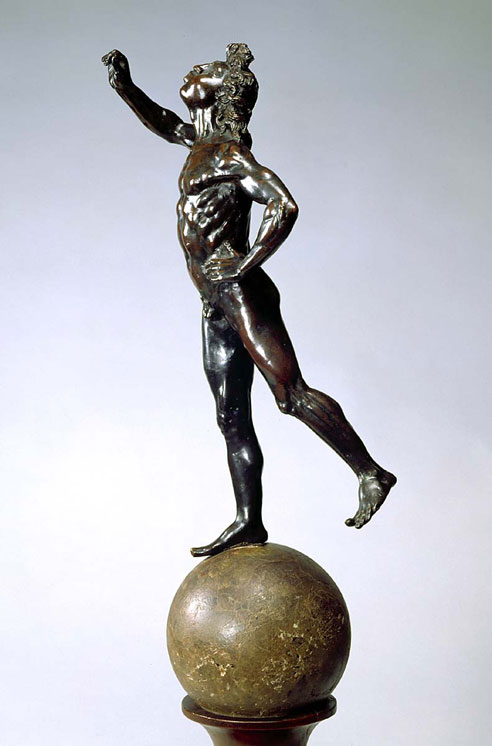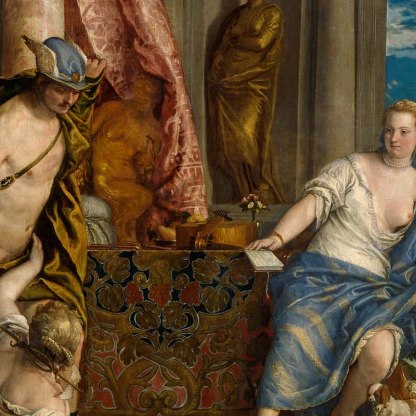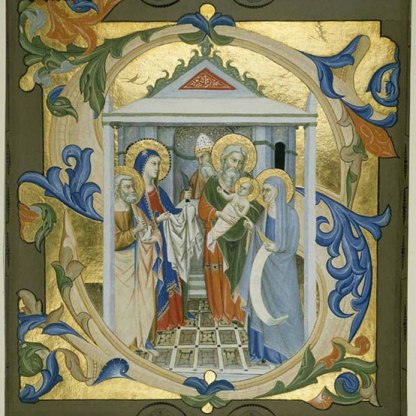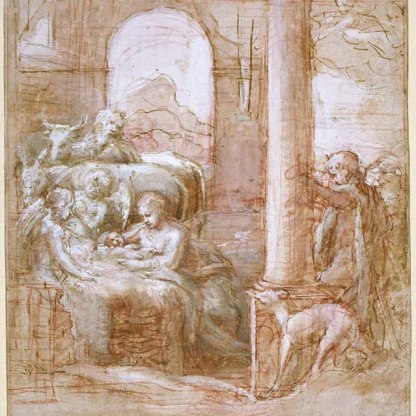Mercury

'This figure, I say, was much praised for a small thing...' Giorgio Vasari, Life of Rustici
Giorgio Vasari, in his biography of the Florentine sculptor Rustici, gives a detailed account of the circumstances in which this graceful bronze figure was made. His admiring description allows us to identify it as the Roman god Mercury, and we are able to glean something of its original appearance and setting:
When Pope Leo came to Florence in the year 1515, Rustici made, at the request of his close friend Andrea del Sarto, some statues that were considered to be very beautiful. Since they impressed Cardinal Giulio de' Medici, he had him make, for the top of the fountain that is in the great court of the Palace of the Medici, the naked bronze Mercury, about one braccio in height, standing on a ball and about to take flight.
In his hands Rustici placed an instrument that is made to revolve by the water that pours down from above: one leg being perforated, a pipe passes through it and through the torso, and the water, having risen to the mouth of the figure, falls upon the instrument, which is balanced with four thin plates fixed like a butterfly's wings, and causes it to revolve.
The remains of the engineering by which this charming effect was achieved can still be seen today. Mercury's lips are pursed into a nozzle and pierced with a hole. There are further apertures in his back, his lower right thigh and left heel.
The revolving instrument in his hand was probably the caduceus, the wand traditionally associated with this messenger god. We see him carrying it in a nineteenth-century bronze in the Fitzwilliam, left [M.3-1854], based upon a sixteenth-century original by the Italian sculptor Giambologna – a work that might have been in part inspired by Rustici's statue.
The caduceus and some wings were removed from Rustici's statue earlier this century in the erroneous belief that they were not original. The globe upon which the god stands today is a modern addition, and the right foot that balances upon it is a nineteenth-century replacement – an indication perhaps that the sculpture was forcibly torn from its original location in the Medici Palace courtyard.
Yet despite these losses and injuries, we can still recognise the quality that attracted Cardinal Giulio back in the early sixteenth century. For all his heavy musculature, there is an elegance to the figure, a sense of lightness, suggesting that he could indeed take flight at any moment.
Unusually for a professional artist in Renaissance Florence, Rustici was of noble birth and financially independent. But although this freed him from the need to ally himself to any one patron or workshop, Vasari tells how he 'attached himself' to Leonardo da Vinci, from whom he learnt the techniques of perspective drawing and bronze casting. The two artists are thought to have collaborated on some works.
Themes and periods
Data from our collections database
Copper alloy, probably bronze, cast, and chased, mounted later on breccia ball and wooden socle.
Copper alloy, probably bronze, cast, and chased, mounted later on breccia ball and wooden socle. Mercury stands balanced on his right leg on a green and red breccia marble ball. His left leg is thrust out stiffly behind him. His left hand rests on his hip, and his right arm is raised, the hand shaped to grasp a slim rod held roughly horizontally. His head is thrust sharply back, the face turned upwards. His lips are pursed, and his mouth shaped as a nozzle pierced in the centre with a round hole (diam 6mm). In the centre of the figure's back is a large irregular oval aperture (7.8 x 3.7 cm) cast with a rebate designed to receive a closely fitted cover.
Commissioned in 1515 by Cardinal Giulio de' Medici, Palazzo Medici, Florence; Sir Francis Cook Bt, Doughty House, Richmond, Surrey (d.1901); 1901, by inheritance, Wyndham Francis Cook, London (where catalogued by Arthur Banks Skinner); 1905 by inheritance, Humphrey Wyndham Cook, London; His sale, Christie's, London, 8 July 1925, lot 242, bt Henry Harris, London; His sale, Sotheby's, London, 24 October 1950, 'The Henry Harris Collection, Catalogue of the Celebrated Collection of Bronzes, Sculpture, Paintings and works of Art of the Italian Renaissance', lot 106, illustrated as frontispiece; bt Sylvia Adams for Lt. Col. the Hon. M.T. Boscawen, D.S.O., M.C.; Bequeathed by the Hon. Mrs Pamela Sherek, from the collection of the late Lt. Col. the Hon. M.T. Boscawen, D.S.O., M.C. in his memory.
Legal notes
Bequeathed by the Hon. Mrs Pamela Sherek, from the collection of the late Lt Col. the Hon. M.T. Boscawen, DSO, MC, in his memory.
Acquisition and important dates
- Method of acquisition: Bequeathed
- Dates: 1995
Dating
- 16th Century, Early
- Renaissance
- Production date: circa AD 1515 : According to Vasari, commissioned in 1515 by Cardinal Giulio de' Medici for a fountain in the courtyard of the Palazzo Medici.
Maker(s)
- Rustici, Giovanni Francesco Sculptor
Place(s) associated
- Florence
Materials used in production
Read more about this recordStories, Contexts and Themes
Other highlight objects you might like
Suggested Curating Cambridge products
Sign up to our emails
Be the first to hear about our news, exhibitions, events and more…






